Post graduate students in Kobe University's Graduate School of Agricultural Science have revealed the role of genes in controlling flowering time in the Brassica rapa family. Satoko Takada and Ayasha Akter demonstrated that a higher level of FLC gene expression is essential for inhibiting flowering in the absence of a cold period. They also discovered that the rate of repression of FLC expression during a cold exposure affects the time of flowering. It is hoped that this understanding can contribute to the efficiency of B. rapa vegetable cultivation in the face of climate change.
The cross-institutional research group also consisted of Associate Professor Ryo Fujimoto (Graduate School of Agricultural Science), Professor Keiichi Okazaki and Researcher Daniel Shea (both of Niigata University Graduate School of Science and Technology), NARO Japan, and members from CSIRO Australia.
These results were first published in the 'Scientific Reports' Journal on September 25, 2019.
Introduction
The B. rapa family is made up of leafy and root vegetables. Varieties of B. rapa include Chinese cabbage, pak choi, turnip and komatsuna (Figure 1). These plants require vernalization in order to flower. Vernalization is a period of prolonged cold exposure which triggers flowering. This has traditionally enabled plants to avoid flowering during winter and instead bloom during more favorable spring weather.
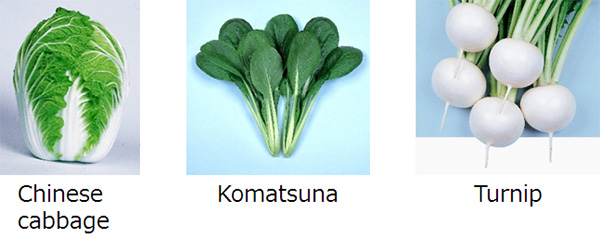
Regulating flowering time is important for plant breeding. Alterations to flowering time can increase the cultivation period and improve tolerance against changes in climate conditions. It can also reduce bolting- which is when plants flower too early. Understanding the vernalization mechanism in B. rapa vegetables is important for efficient cultivation.
Extensive studies into the vernalization mechanism in Arabidopsis thaliana (At) have found that there are two genes that play an important role in regulating flowering time- FRIGIDA (FRI) and FLOWERING LOCUS C (FLC). The FRI gene in A. thaliana (AtFRI) regulates the AtFLC gene responsible for flowering. Before the plant is exposed to cold temperatures, AtFRI causes the AtFLC gene to be expressed, preventing flowering. Subsequent vernalization causes the AtFLC gene to be inhibited, thus allowing A. thaliana to flower (see Figure 2).
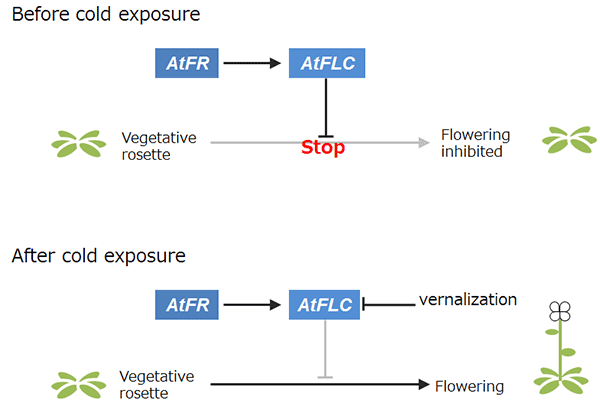
The current study sought to illuminate how the FRI and FLC genes are involved in this process in B. rapa and to understand their role in early flowering and late flowering lines.
Methodology
The research group discovered two FRI genes (BrFRIa, BrFRIb) and four FLC genes (BrFLC1, BrFLC2, BrFLC3, BrFLC5) in B. rapa. Next, studies were conducted to determine the function of these genes using A. thaliana as a model.
The A. thaliana used was an early flowering model with no AtFRI function and therefore no AtFLC expression. When the B. rapa gene BrFRIb was transformed into this early flowering A. thaliana, this triggered the expression of AtFLC, thus making the plant late flowering. This shows that BrFRIb has an FLC triggering function (Figure 3). Subsequent experiments on this early flowering A. thaliana revealed that the B. rapa genes BrFLC1, BrFLC2 and BrFLC3 all caused the plant to become late flowering. This showed that all three of these BrFLC genes are floral repressors.
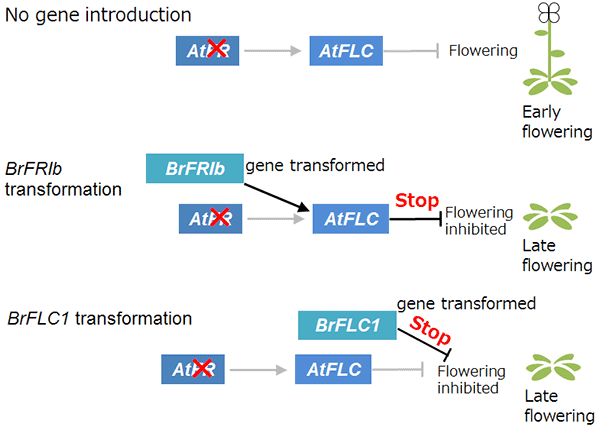
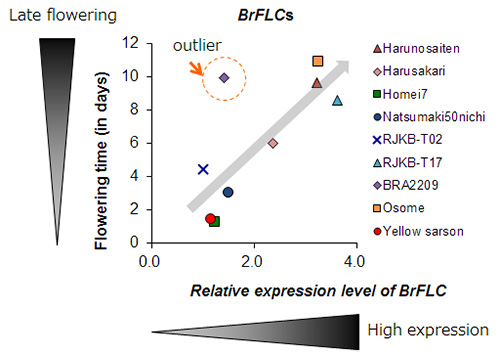
Next, the researchers investigated how long nine lines of B. rapa took to flower after being exposed to cold (4℃) for 4 weeks. After the cold treatment, the plants were transferred to soil and grown in normal conditions (at 22℃). The number of days required to flower was measured. As shown in Figure 4, lines such as Homei were early flowering while Harunosaiten and BRA2209 were late flowering.
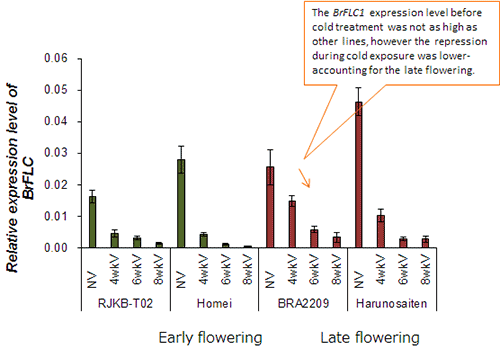
In order to determine the impact of BrFLC genes on the vernalization requirements of B. rapa, the expression levels of BrFLC genes in these nine lines were measured. It was found that during cold exposure, early flowering varieties contained low levels of BrFLC expression and late flowering varieties contained high levels of BrFLC expression. This shows that BrFLC expression levels are associated with flowering time (Figure 5).
Conclusion
Resistance to bolting in B. rapa is an important trait for the successful cultivation of these vegetables. The results revealed that in order to prevent cabbage, komatsuna and turnips from flowering while it is still cold, a high quantitative expression of BrFLC genes is needed prior to cold exposure.
Journal information
- Title
- "The role of FRIGIDA and FLOWERING LOCUS C genes in flowering time of Brassica rapa leafy vegetables"
DOI:10.1038/s41598-019-50122-2
- Authors
- Satoko Takada+, Ayasha Akter+, Etsuko Itabashi, Namiko Nishida, Daniel J. Shea, Naomi Miyaji, Hasan Mehraj, Kenji Osabe, Motoki Shimizu, Takeshi Takasaki-Yasuda, Tomohiro Kakizaki, Keiichi Okazaki, Elizabeth S. Dennis, Ryo Fujimoto
+ These authors equally contributed to this work
- Journal
- Scientific Reports






